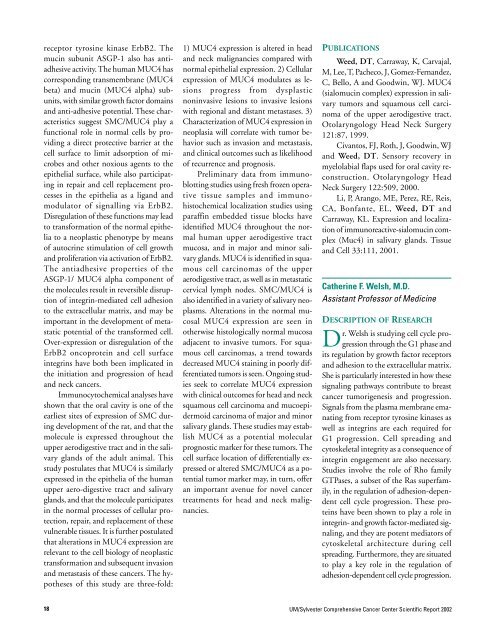tumor cell biology program - Sylvester Comprehensive Cancer Center
tumor cell biology program - Sylvester Comprehensive Cancer Center
tumor cell biology program - Sylvester Comprehensive Cancer Center
You also want an ePaper? Increase the reach of your titles
YUMPU automatically turns print PDFs into web optimized ePapers that Google loves.
eceptor tyrosine kinase ErbB2. The<br />
mucin subunit ASGP-1 also has antiadhesive<br />
activity. The human MUC4 has<br />
corresponding transmembrane (MUC4<br />
beta) and mucin (MUC4 alpha) subunits,<br />
with similar growth factor domains<br />
and anti-adhesive potential. These characteristics<br />
suggest SMC/MUC4 play a<br />
functional role in normal <strong>cell</strong>s by providing<br />
a direct protective barrier at the<br />
<strong>cell</strong> surface to limit adsorption of microbes<br />
and other noxious agents to the<br />
epithelial surface, while also participating<br />
in repair and <strong>cell</strong> replacement processes<br />
in the epithelia as a ligand and<br />
modulator of signalling via ErbB2.<br />
Disregulation of these functions may lead<br />
to transformation of the normal epithelia<br />
to a neoplastic phenotype by means<br />
of autocrine stimulation of <strong>cell</strong> growth<br />
and proliferation via activation of ErbB2.<br />
The antiadhesive properties of the<br />
ASGP-1/ MUC4 alpha component of<br />
the molecules result in reversible disruption<br />
of integrin-mediated <strong>cell</strong> adhesion<br />
to the extra<strong>cell</strong>ular matrix, and may be<br />
important in the development of metastatic<br />
potential of the transformed <strong>cell</strong>.<br />
Over-expression or disregulation of the<br />
ErbB2 oncoprotein and <strong>cell</strong> surface<br />
integrins have both been implicated in<br />
the initiation and progression of head<br />
and neck cancers.<br />
Immunocytochemical analyses have<br />
shown that the oral cavity is one of the<br />
earliest sites of expression of SMC during<br />
development of the rat, and that the<br />
molecule is expressed throughout the<br />
upper aerodigestive tract and in the salivary<br />
glands of the adult animal. This<br />
study postulates that MUC4 is similarly<br />
expressed in the epithelia of the human<br />
upper aero-digestive tract and salivary<br />
glands, and that the molecule participates<br />
in the normal processes of <strong>cell</strong>ular protection,<br />
repair, and replacement of these<br />
vulnerable tissues. It is further postulated<br />
that alterations in MUC4 expression are<br />
relevant to the <strong>cell</strong> <strong>biology</strong> of neoplastic<br />
transformation and subsequent invasion<br />
and metastasis of these cancers. The hypotheses<br />
of this study are three-fold:<br />
1) MUC4 expression is altered in head<br />
and neck malignancies compared with<br />
normal epithelial expression. 2) Cellular<br />
expression of MUC4 modulates as lesions<br />
progress from dysplastic<br />
noninvasive lesions to invasive lesions<br />
with regional and distant metastases. 3)<br />
Characterization of MUC4 expression in<br />
neoplasia will correlate with <strong>tumor</strong> behavior<br />
such as invasion and metastasis,<br />
and clinical outcomes such as likelihood<br />
of recurrence and prognosis.<br />
Preliminary data from immunoblotting<br />
studies using fresh frozen operative<br />
tissue samples and immunohistochemical<br />
localization studies using<br />
paraffin embedded tissue blocks have<br />
identified MUC4 throughout the normal<br />
human upper aerodigestive tract<br />
mucosa, and in major and minor salivary<br />
glands. MUC4 is identified in squamous<br />
<strong>cell</strong> carcinomas of the upper<br />
aerodigestive tract, as well as in metastatic<br />
cervical lymph nodes. SMC/MUC4 is<br />
also identified in a variety of salivary neoplasms.<br />
Alterations in the normal mucosal<br />
MUC4 expression are seen in<br />
otherwise histologically normal mucosa<br />
adjacent to invasive <strong>tumor</strong>s. For squamous<br />
<strong>cell</strong> carcinomas, a trend towards<br />
decreased MUC4 staining in poorly differentiated<br />
<strong>tumor</strong>s is seen. Ongoing studies<br />
seek to correlate MUC4 expression<br />
with clinical outcomes for head and neck<br />
squamous <strong>cell</strong> carcinoma and mucoepidermoid<br />
carcinoma of major and minor<br />
salivary glands. These studies may establish<br />
MUC4 as a potential molecular<br />
prognostic marker for these <strong>tumor</strong>s. The<br />
<strong>cell</strong> surface location of differentially expressed<br />
or altered SMC/MUC4 as a potential<br />
<strong>tumor</strong> marker may, in turn, offer<br />
an important avenue for novel cancer<br />
treatments for head and neck malignancies.<br />
PUBLICATIONS<br />
Weed, DT, Carraway, K, Carvajal,<br />
M, Lee, T, Pacheco, J, Gomez-Fernandez,<br />
C, Bello, A and Goodwin, WJ. MUC4<br />
(sialomucin complex) expression in salivary<br />
<strong>tumor</strong>s and squamous <strong>cell</strong> carcinoma<br />
of the upper aerodigestive tract.<br />
Otolaryngology Head Neck Surgery<br />
121:87, 1999.<br />
Civantos, FJ, Roth, J, Goodwin, WJ<br />
and Weed, DT. Sensory recovery in<br />
myelolabial flaps used for oral cavity reconstruction.<br />
Otolaryngology Head<br />
Neck Surgery 122:509, 2000.<br />
Li, P, Arango, ME, Perez, RE, Reis,<br />
CA, Bonfante, EL, Weed, DT and<br />
Carraway, KL. Expression and localization<br />
of immunoreactive-sialomucin complex<br />
(Muc4) in salivary glands. Tissue<br />
and Cell 33:111, 2001.<br />
Catherine F. Welsh, M.D.<br />
Assistant Professor of Medicine<br />
DESCRIPTION OF RESEARCH<br />
Dr. Welsh is studying <strong>cell</strong> cycle progression<br />
through the G1 phase and<br />
its regulation by growth factor receptors<br />
and adhesion to the extra<strong>cell</strong>ular matrix.<br />
She is particularly interested in how these<br />
signaling pathways contribute to breast<br />
cancer <strong>tumor</strong>igenesis and progression.<br />
Signals from the plasma membrane emanating<br />
from receptor tyrosine kinases as<br />
well as integrins are each required for<br />
G1 progression. Cell spreading and<br />
cytoskeletal integrity as a consequence of<br />
integrin engagement are also necessary.<br />
Studies involve the role of Rho family<br />
GTPases, a subset of the Ras superfamily,<br />
in the regulation of adhesion-dependent<br />
<strong>cell</strong> cycle progression. These proteins<br />
have been shown to play a role in<br />
integrin- and growth factor-mediated signaling,<br />
and they are potent mediators of<br />
cytoskeletal architecture during <strong>cell</strong><br />
spreading. Furthermore, they are situated<br />
to play a key role in the regulation of<br />
adhesion-dependent <strong>cell</strong> cycle progression.<br />
18<br />
UM/<strong>Sylvester</strong> <strong>Comprehensive</strong> <strong>Cancer</strong> <strong>Center</strong> Scientific Report 2002
















